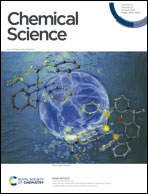Sodium silylsilanolate as a precursor of silylcopper species†
Abstract
Silylcoppers function as convenient and effective sources of silicon functional groups. Commonly used precursors for those species have been limited to certain symmetric disilanes and silylboranes. This fact renders the development of silylcopper precursors desirable so that more diverse silyl groups could be efficiently delivered. Here we extend the utility of sodium silylsilanolates as competent precursors of silylcoppers. A silanolate unit operates as an auxiliary to transfer a variety of silyl groups to the copper centre, which was demonstrated in the copper-catalysed hydrosilylation of internal alkynes, α,β-unsaturated ketones, and allenes. Our mechanistic studies through DFT calculation suggested that a copper silylsilanolate undergoes intramolecular oxidative addition of the Si–Si bond to the copper centre to generate a silylcopper, in contrast to the typical formal σ-bond metathesis mechanism for conventional disilanes or silylboranes and copper alkoxides. Accordingly, sodium silylsilanolate has been established as an expeditious precursor of a variety of silylcopper species.



 Please wait while we load your content...
Please wait while we load your content...